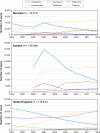Patterns of use of antimuscarinic drugs to treat overactive bladder in Denmark, Sweden, and the United Kingdom
- PMID: 30260993
- PMCID: PMC6160033
- DOI: 10.1371/journal.pone.0204456
Patterns of use of antimuscarinic drugs to treat overactive bladder in Denmark, Sweden, and the United Kingdom
Abstract
Purpose: To describe the use of antimuscarinic drugs to treat overactive bladder (OAB) in Denmark, Sweden, and the United Kingdom (UK).
Methods: We identified new users of darifenacin, fesoterodine, oxybutynin, solifenacin, tolterodine, and trospium aged 18 years or older from the Danish National Registers (2004-2012), the Swedish National Registers (2006-2012), and UK Clinical Practice Research Datalink (2004-2012). Users were followed until disenrollment, cancer diagnosis, death, or study end. Treatment episodes, identified by linking consecutive prescriptions, were described with respect to duration, drug switch, and drug add-on.
Results: Mean age of OAB drug users was 66 years in Denmark (n = 72,917) and Sweden (n = 130,944), and 62 years in the UK (n = 119,912); 60% of Danish and Swedish patients and 70% of UK patients were female. In Denmark, of 224,680 treatment episodes, 39% were with solifenacin, and 35% with tolterodine; 2% were with oxybutynin. In Sweden, of 240,141 therapy episodes, 37% were with tolterodine and 35% with solifenacin; 5% were with oxybutynin. In the UK, of 245,800 treatment episodes, 28% were with oxybutynin, 27% with solifenacin, and 26% with tolterodine. In the three countries, 49%-52% of treatment episodes comprised one prescription and over 80% of episodes ended because of no refill; less than 20% ended because of a switch to another antimuscarinic. During the study years, we observed a change in OAB treatment preference from tolterodine to solifenacin.
Conclusions: In these cohorts, persistence with antimuscarinic drugs was low. By 2012, the preferred drug was solifenacin; oxybutynin use was marginal in Nordic countries compared with the UK.
Conflict of interest statement
The authors have declared that no competing interests exist. Authors are employees of Astellas Pharma Global Development (WJA, KA, MDS), RTI Health Solutions (AVM, AA, CB, LJM, SPG), University of Southern Denmark (JH, NSK, AP), and the Karolinska Institutet (ML, SB, IAB). This does not alter our adherence to PLOS ONE policies on sharing data and materials.
Figures
References
-
- Abrams P, Cardozo L, Fall M, Griffiths D, Rosier P, Ulmsten U, et al. The standardisation of terminology in lower urinary tract function: report from the standardisation sub-committee of the International Continence Society. Urology. 2003; 61 (1): 37–49. - PubMed
-
- Irwin DE, Milsom I, Hunskaar S, Reilly K, Kopp Z, Herschorn S, et al. Population-based survey of urinary incontinence, overactive bladder, and other lower urinary tract symptoms in five countries: results of the EPIC study. Eur Urol. 2006; 50 (6): 1306–1314; discussion 1314–1305. 10.1016/j.eururo.2006.09.019 - DOI - PubMed
Publication types
MeSH terms
Substances
LinkOut - more resources
Full Text Sources
Other Literature Sources
Medical


